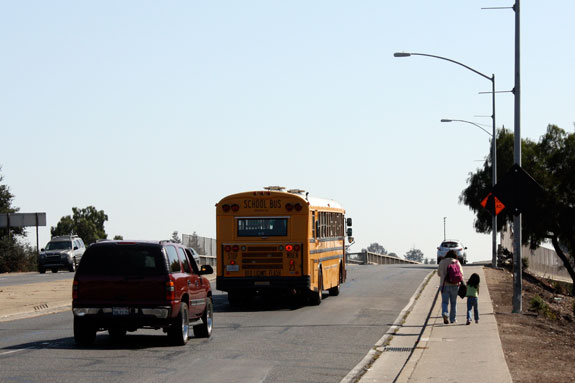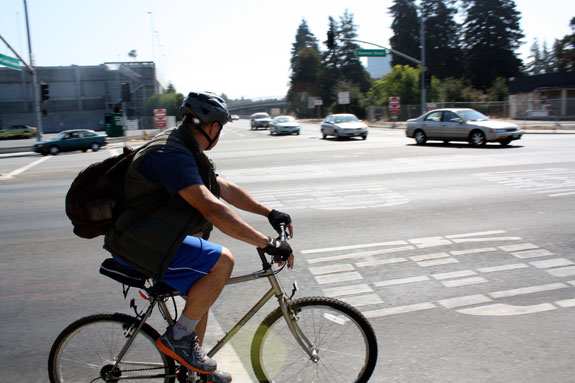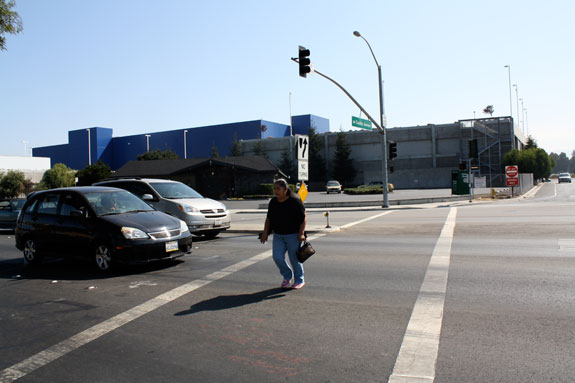
This is the first in a series of stories on East Palo Alto’s proposed bicycle and pedestrian overcrossing.
It takes Maria del Socorro Macias about 40 minutes to walk from her neighborhood on the west side of East Palo Alto to her kids’ schools on the east side of Highway 101. To get there, she has to take a narrow sidewalk on the University Avenue overpass and walk through the city’s most congested intersection.
“It is very dangerous,” del Socorro Macias, 48, told Streetsblog through a Spanish interpreter. "There are numerous traffic lights to cross to get to the schools. It is especially dangerous walking at night, but I often do it because I attend school meetings and parent workshops."
On foot and by bicycle, it’s a risky journey that countless East Palo Altans have been forced to take for decades, ever since the freeway sliced through their community. To visit friends, to get to church, to the library, or to Mi Pueblo -- for now the city’s only grocery store -- west side residents, many of whom have low incomes and don’t own cars, must contend with the freeway crossing and unforgiving street traffic.
"There’s a four-foot wide sidewalk that leads to the intersection with the highest traffic in the city," said Brent Butler, the city’s planning manager. "It’s unsafe."
A 2010 analysis noted that, among 97 California cities, East Palo Alto has the third-highest ratio of pedestrian collisions to the volume of driving.
Since East Palo Alto was incorporated in 1983, city leaders have envisioned building a bicycle and pedestrian overcrossing to reconnect the west side, according to vice mayor and longtime community activist Ruben Abrica. But over the 80s and 90s more pressing issues -- crime, a drug epidemic -- gripped the city, and talk of at least improving the University overpass never turned to action.
“We are the only city on the Peninsula without a bike and pedestrian overcrossing,” said Kamal Fallaha, East Palo Alto’s traffic engineer.
There have been missed opportunities to tie a path over the highway to redevelopment, said Abrica. In the past few years, however, the city has made the overcrossing its number one transportation project, and it recently won funding to improve the University overpass to make it friendlier for pedestrians and bike riders.
“Through the commitment and insistence of the City Council, we have made it a priority,” said Abrica, who lives on the west side. "Little by little we have been putting in place some of the things we felt were missing.”


The West Side
With its plush Four Seasons Hotel, some people might mistake the west side of East Palo Alto for Menlo Park or Palo Alto, but it’s where 35 percent of the city’s residents live. In 2005, the five-star hotel was built over what was known as Whiskey Gulch, East Palo Alto’s once-thriving business district, which was destroyed when Highway 101 was widened in the late 1950s.
Today, the west side consists mostly of multi-family affordable housing complexes. The largest, Woodland Park, has a tumultuous ownership history, and many residents opposed its recent sale to Equity Residential, the giant property company owned by billionaire Sam Zell.
East Palo Alto has a long history of court battles with big landlords over tenant protections. "The one thing that integrated the west side to the east side much more was the rent law. By having a law that protects tenants, people became acutely aware that they were part of the city of East Palo Alto,” said Abrica.
Despite the physical barrier that is Highway 101, Abrica said west side residents have strong connections to the east side. Those who argued for incorporation almost 30 years ago had to prove that to the local agency formation commission.
Younger generations of East Palo Altans have also moved to the west side because they can’t afford to buy the single-family homes that predominate on the east side.
“Over the years I've seen more families who come and visit and they have little events and I've seen more and more interactions like, ‘Oh, you're the son and daughter of mister so and so,’ and, ‘How's your dad doing?’ That's been a nice affirmation that we are one community in spite of the freeway.”
There isn’t a single park on the west side, or any open space, but San Francisquito Creek graces the edge. “It’s beautiful. I often take walks there,” said Abrica.
The Freeway
The history of the freeway is recounted in the 1996 documentary, Dreams of a City: Creating East Palo Alto. In interviews, activists talked about how East Palo Alto residents fought against the freeway and its expansion decades later, but had no political influence over the county and Caltrans because the city was unincorporated.
“We didn’t have the money or the votes,” one activist recalled. Some longtime residents still hold a deep mistrust of government agencies, and given that the city’s troubles have been historically overlooked, that feeling has carried over to some younger residents.
East Palo Alto and its population of mostly Latinos and African Americans remain burdened by effects of the freeway. It has one of the highest asthma rates in the Bay Area. On any given day, 400,000 automobiles travel through the city on 101.
“All of the incomplete combustion particles, the particulate matter that's loading our youth here, is detrimental to their long-term life, their morbidity,” said Butler, the city planner, adding that the auto-oriented environment contributes to physical inactivity, which leads to a variety of health problems.
Poverty, lower levels of education and other social factors compound the issues in East Palo Alto, where the average age is 28 and the average life expectancy is 61, 14 years short of the countywide average.
Shaking a Bad Image
The East Palo Alto known for its high murder rate and drug problem in 1992 is not the East Palo Alto of today, “but for some reason that still stays with people,” said Butler. “Back then there was 43 murders a year, and now we’re down to six, but that is indelibly imprinted on people’s brains.”
A survey of 400 residents released last week found about half believe the quality of life is “excellent or good,” 34 percent said it was “fair,” and 17 percent described it as “poor or very poor.” One of the most common suggestions from residents was for the city to improve its infrastructure and streets.
Realizing a Dream
The new pedestrian and bicycle overcrossing will go a long way toward satisfying some of the residents' concerns. This week, the East Palo Alto Planning Commission unanimously passed a Complete Streets policy and the city is working to improve the streets for bike riders and pedestrians.
“All the families that hear about (the overcrossing), whether they live on that side of East Palo Alto, or not, they just think it's a really good thing,” said Jennifer Acuña, the parent liaison at Ronald McNair Academy who also works for the Peninsula Conflict Resolution Center.
The proposed overcrossing would be located south of the University overpass, starting around Clark and East Bayshore roads on the east side, and extend over the freeway with a landing on Newell Road on the west side. It would also benefit bike commuters from Palo Alto who would have a safer connection to Facebook headquarters in Menlo Park.
For Maria del Socorro Macias, the new overcrossing would make her walking commute much easier, shortening the distance to get to school for three children, ages 8, 10, and 12.
“It would be a great time saver. I also wouldn't have to use the public bus as much, which would save money and time,” she said. “It would allow me to volunteer at the school more often. My family would feel safe and my children would not have to worry about getting to school late.”
Abrica said when the overcrossing is finally built, it will be a dream come true.
“I think in the next two or three years we're going to get it done. We have to. In fact, it would be a great birthday present to the community, to the city, on its 30th anniversary, which is next year.”
Next: What should East Palo Alto’s new bike and pedestrian overcrossing look like? We’ll delve into the proposed design, and what it will take to build it.







